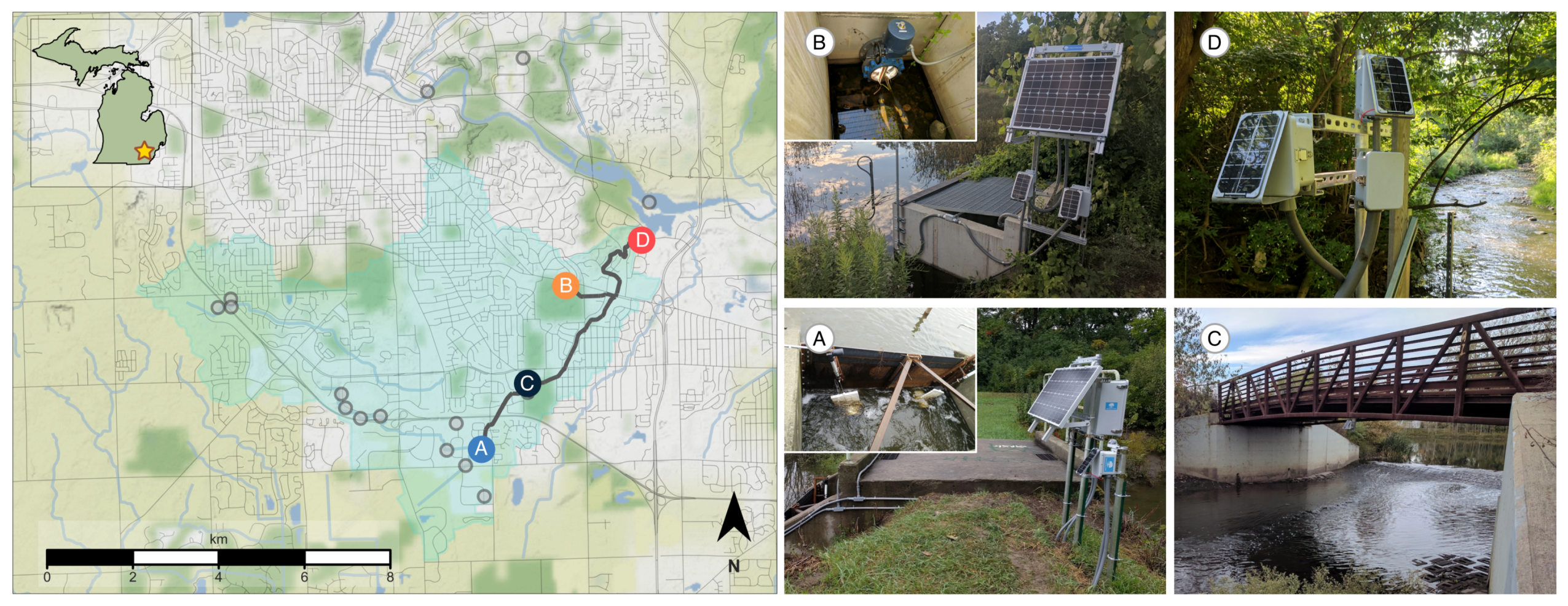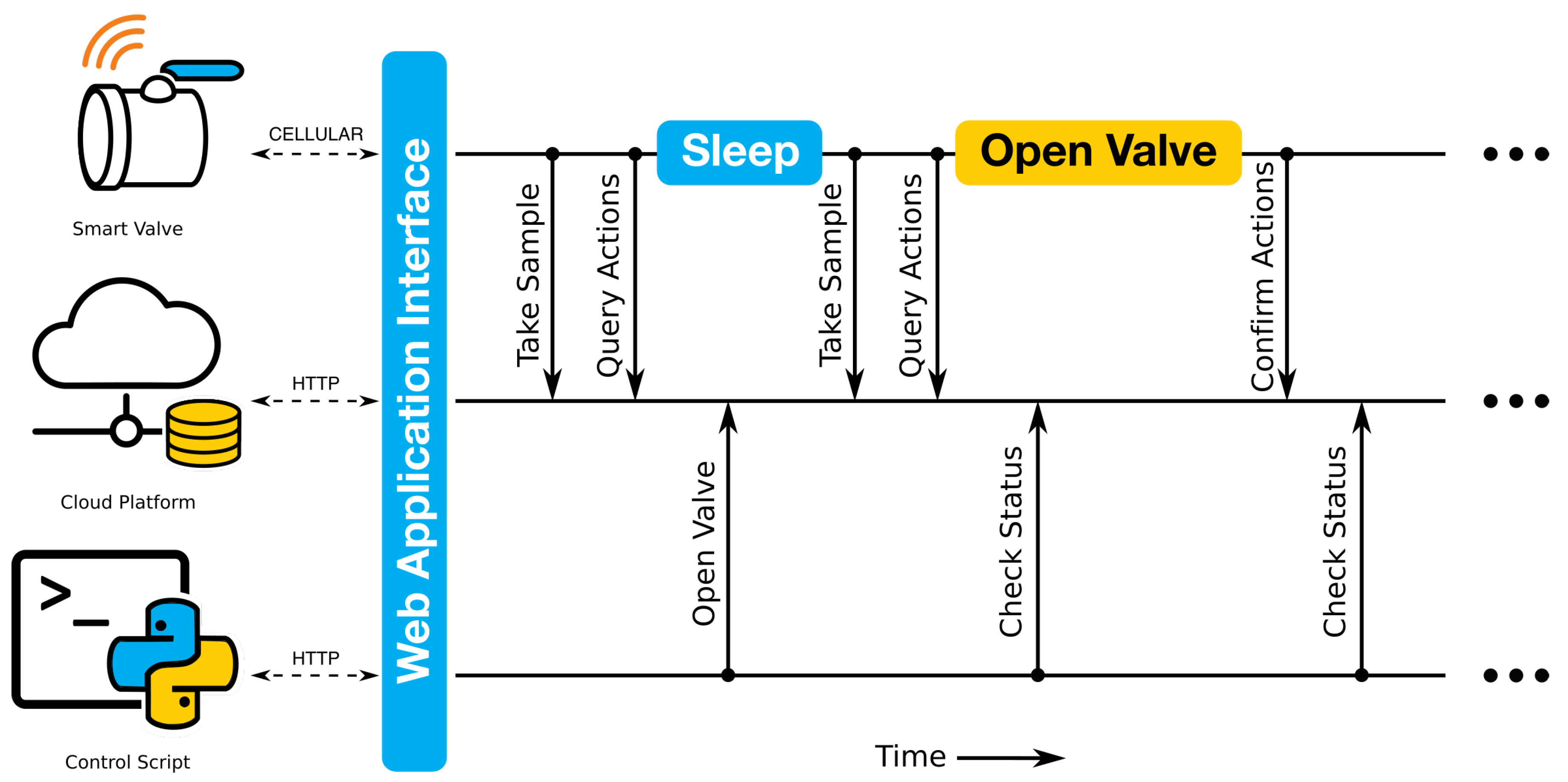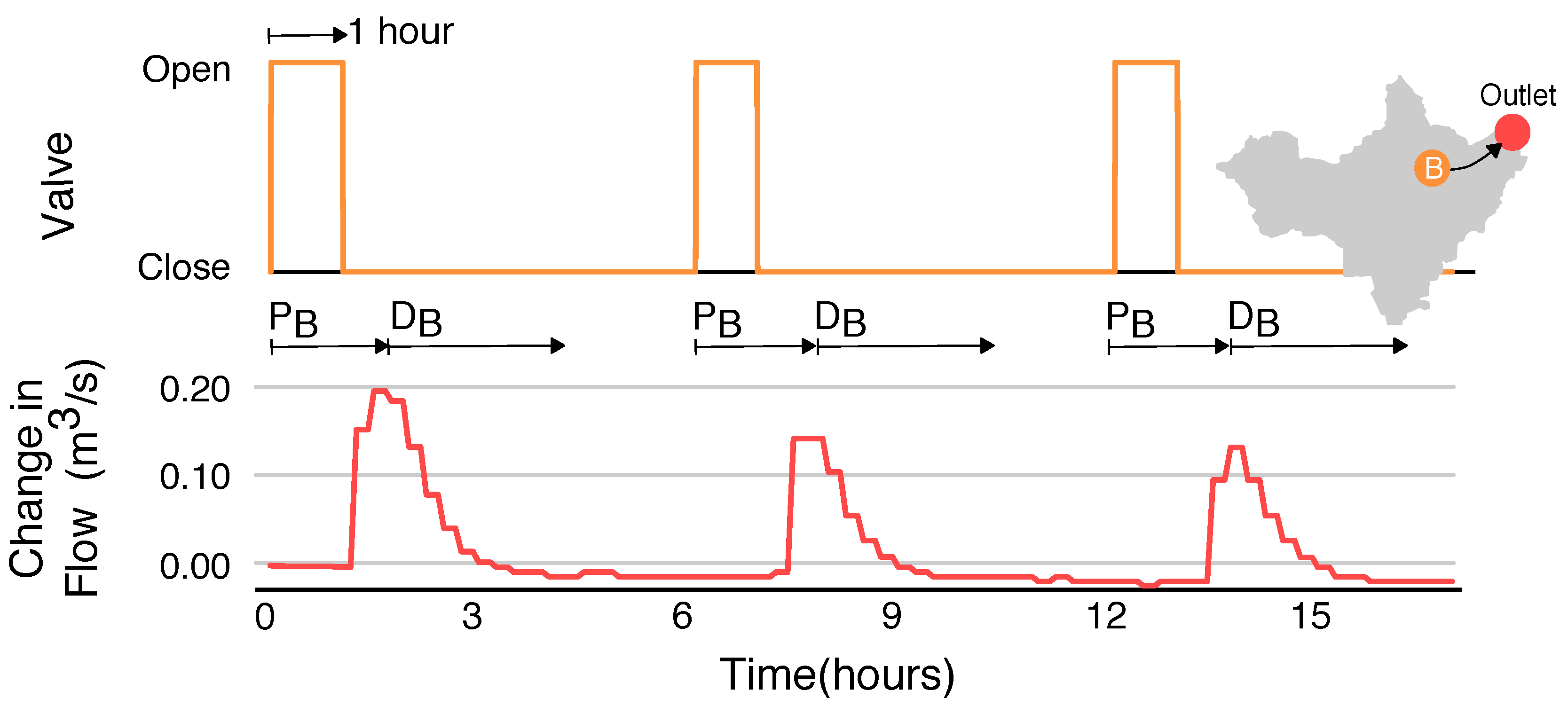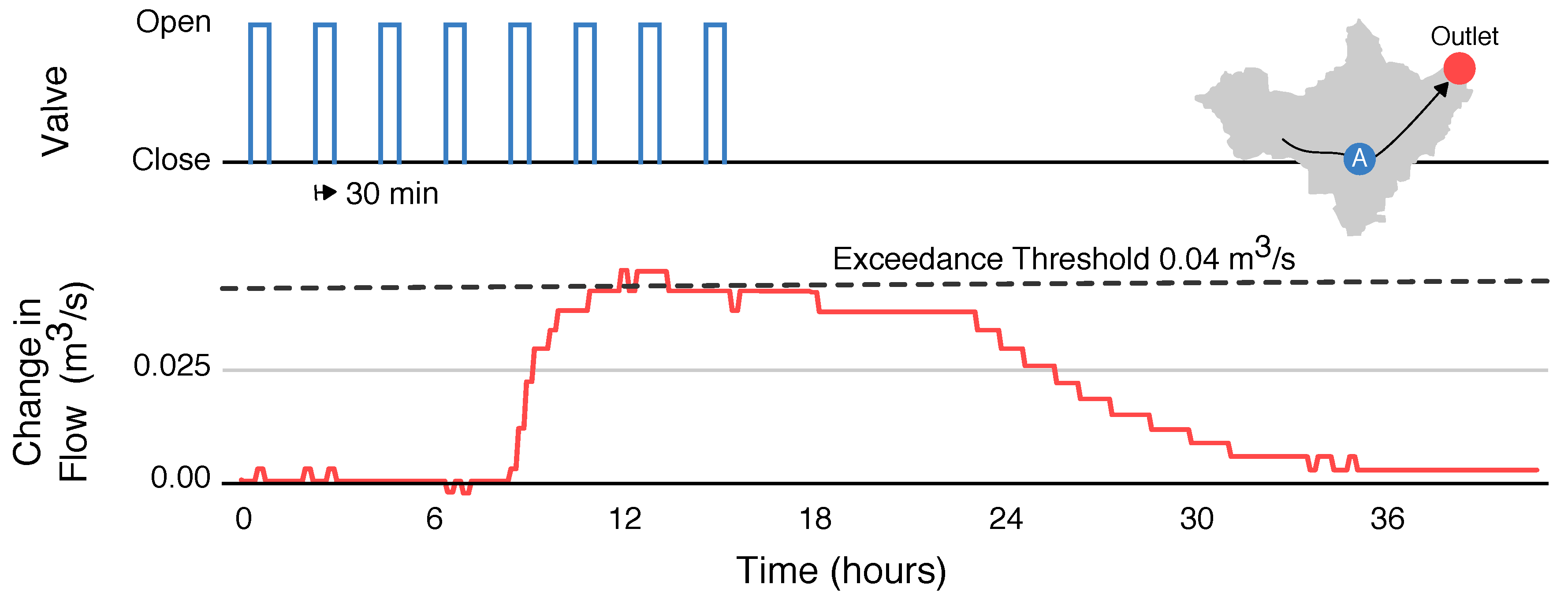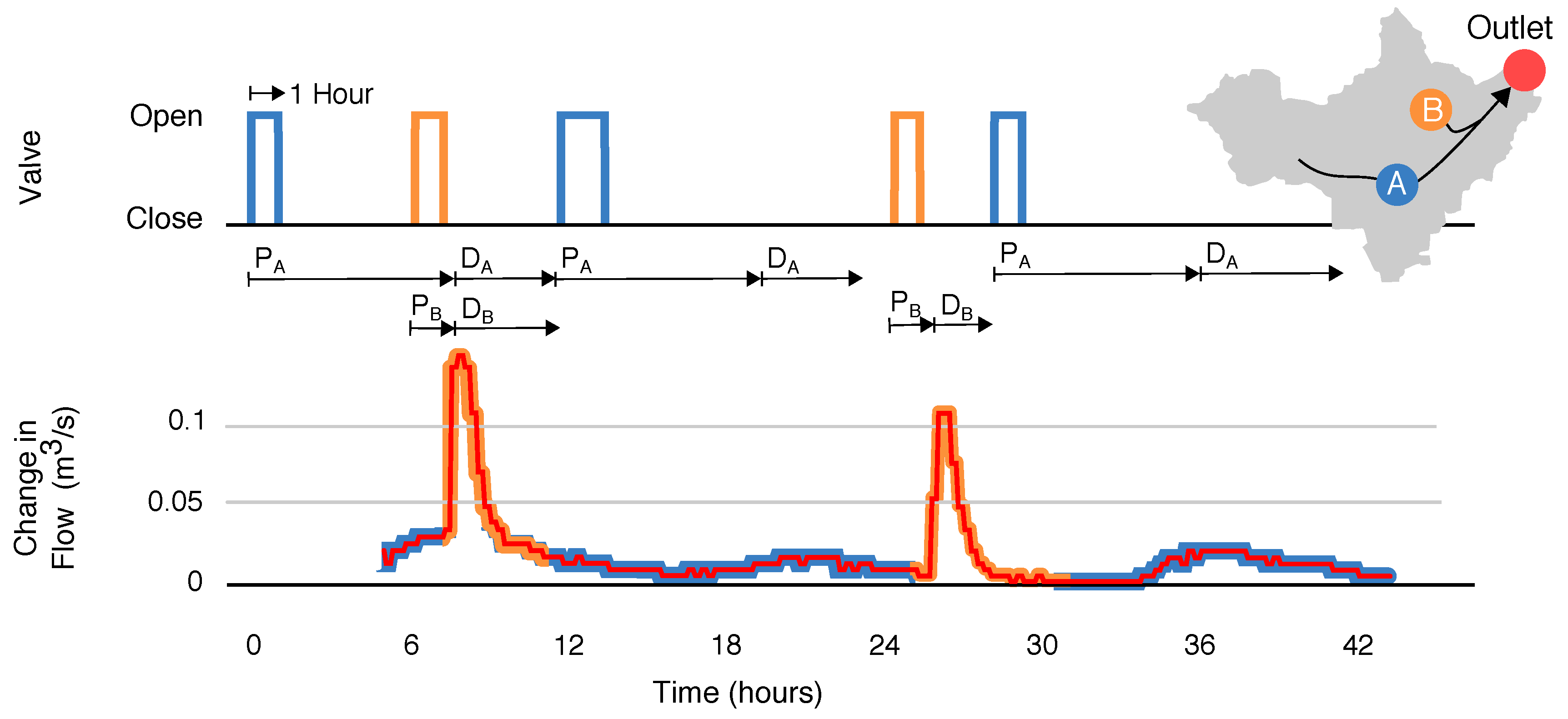1. Introduction
Burdened by aging infrastructure, growing populations and changing hydrologic conditions, many municipalities struggle to adequately manage stormwater [
1]. Flash flooding can occur when stormwater infrastructure is unable to convey runoff away from developed areas [
2]. At the same time, pollutants from urban runoff—such as nutrients, heavy metals and microbes—can contaminate downstream waterbodies, damaging aquatic habitats and resulting in toxic algal blooms [
1]. Traditionally, civil engineers have addressed these challenges by building larger storage and conveyance infrastructure (e.g., basins and pipes). However, this approach suffers from a number of important disadvantages. First, new construction is expensive, and is often unfeasible for chronically underfunded stormwater departments [
3]. Second, static designs are inflexible to future changes in weather, population growth, and regulatory requirements [
2]. Third, overdesigned conveyance systems can cause flooding, erosion and damage to downstream property and ecosystems, which ultimately necessitates further remediation and construction [
1]. In the face of increasing urbanization and more frequent extreme weather events [
4,
5], new strategies are needed to ensure effective management of stormwater.
In contrast to traditional
steel-and-concrete solutions, real-time control has emerged as a novel means to improve the performance of stormwater systems at minimal expense. Drawing on wireless communications, low-power microcontrollers, and modern advances in control theory, these systems achieve performance benefits by reconfiguring water infrastructure in real time [
1,
6]. Real-time control of stormwater basins, for instance, can improve water quality following a storm event by enhancing removal of contaminants [
1]. Similarly, active regulation of discharges through constructed wetlands can improve water quality and rehabilitate aquatic habitats [
6,
7]. More broadly, by controlling flows over a large network, operators can harness the latent treatment capacity of many distributed stormwater assets, effectively turning urban watersheds into distributed wastewater treatment plants [
1,
6].
A small number of studies have evaluated the benefits of real-time stormwater control. Most of these studies describe retrofits of isolated sites for rainwater capture and on-site pollutant treatment. Middleton and Barrett (2008) show that equipping existing retention basins with real-time controllers can reduce stormwater pollutant loads downstream by increasing the retention time of captured stormwater [
8]. Roman et al. (2017) describe an adaptively-controlled rainwater harvesting system in New York City that captures 35–60% more rainwater than conventional systems [
9]. Similarly, Klenzendorf et al. (2015) describe a rainwater harvesting pilot project and a retention basin retrofitted for real-time control in Austin, Texas [
10]. The authors show that the controlled retention basin reduces deposition of nitrogen and total suspended solids (TSS) into the downstream system. These studies demonstrate that active control can significantly improve the performance of existing sites at a lower cost than new construction. However, benefits are only examined at a local scale. This distinction is important, given that localized practices do not necessarily achieve the best system-scale outcomes. Indeed, some research indicates that when local best management practices are implemented without accounting for global outcomes, they can produce adverse flow conditions at the watershed scale [
11].
Currently, the benefits of coordinated stormwater control are poorly understood. Inspiration for the benefits of system-level control can be taken from sewer operations. While most sewer systems still only rely on local control logic, such as water level setpoints [
12], recent work has demonstrated how wider benefits can be achieved through the cooperative action of multiple controllers working in tandem. The cities of Copenhagen and Barcelona, for instance, implement a combination of local rule-based control, and some higher-level optimization that jointly coordinates actions between groups of actuators [
13]. Montestruque and Lemmon (2015) describe CSOnet, a sewer control network consisting of 120 sensors and 12 actuators in the city of South Bend, Indiana [
3]. This network uses dynamic control algorithms to adaptively balance hydraulic loads throughout the sewer’s interceptor lines, ultimately reducing combined sewer overflows (CSOs) by as much as 25%. While these systems achieve impressive system-scale control of a large sewer networks, it is still unclear how lessons learned from these proprietary sewer control approaches may translate to the broader control of urban watersheds and separated stormwater systems.
In this study, we describe an approach for managing stormwater discharges across an urban watershed using internet-connected valves and sensors. We show that by actively coordinating releases from two parallel retention basins, we can produce desirable flow regimes at a target location downstream, which would not be possible with passive infrastructure alone. This study takes place in four phases. In the first phase, we describe the development of a real-time stormwater control system in the city of Ann Arbor, Michigan. Building on an existing wireless sensing and control network described in Bartos et al. (2018) [
6], we demonstrate how static retention basins can be retrofitted with internet-controlled valves, and present a new method for controlling these basins using a controller scheduling application. In the second phase, we characterize the ability of the control network to shape the downstream hydrograph by releasing impulses of different sizes from two retention basins and determining the magnitude, travel time, and decay envelope of the resulting waves. In the third phase, we use the data gathered from this exploratory analysis to determine the control input needed to produce a flat hydrograph at the outlet of the watershed. We discuss how this control strategy can be used to prevent erosion and reduce phosphorus loads into downstream waterbodies. Finally, in the fourth phase, we show how control inputs can be timed to produce synchronized and de-synchronized pulses at a downstream target location. In addition to demonstrating the precision of the control system, this experiment shows how interleaving pulses can be used to free up capacity in upstream retention basins without inducing synchronized flashy flows downstream. We discuss how these simple control “building blocks” can be used by system operators to achieve more sophisticated stormwater management targets. Unlike most existing systems, our control network uses an open-source hardware and software stack, making it freely available to municipalities that are interested in implementing their own smart stormwater control systems. Thus, when combined with supplementary
how-to documentation on
open-storm.org, this study provides the foundation for an “operator’s manual” for real-time control of urban watersheds.
3. Characterizing Control Actions
Before evaluating potential control strategies, we first characterize the ability of each control site to shape downstream flows. Specifically, we quantify the travel time
P and decay time
D of various waves as they move between the originating control site and the outlet of the watershed. The characterization is accomplished by releasing pulses of different durations from each stormwater basin and then observing the resulting waves that these pulses generate downstream. To limit confounding effects caused by rainfall, these experiments are carried out during dry conditions (at least four days following a storm).
Figure 3 shows a 1-h release, 4-h release, and 48-h release from retention basin A (shown left to right, respectively). The 48-h release empties the retention basin, meaning that this release characterizes the maximum possible output from site A. The travel times for each wave from site A to site C are approximately 3.5 h (time to start of rise) and 6–8 h (time to peak), with faster rise times for the larger releases due to nonlinearities in the speed of wave propagation. The decay times for each release are 6 h, 18 h and 44 h, respectively. From this experiment, it can be seen that the maximum change in flow that site A can generate at the outlet is roughly 0.17 m
/s. Similar experiments are used to characterize site B. From these experiments, we estimate average travel times from site B to the outlet of 1.5 h (time to start of rise) and 1.8 h (time to peak), with an average decay time of 3 h, and a maximum change in flow of approximately 0.2 m
/s.
In addition to release duration, sites are also characterized with respect to the hydraulic head (water level) of the originating retention basin.
Figure 4 shows the result of releasing three 1-h pulses from site B, without allowing the basin to refill between releases. While the same duration is used for each release, the hydraulic head (stored volume) of the retention basin decreases with each pulse. Thus, the resulting wave becomes smaller with each successive opening of the valve, even though the same input signal is used. In spite of this difference, the travel times and decay times of the waves remain consistent between each release. The magnitude of the resulting wave varies from roughly 0.2 m
/s to 0.13 m
/s, depending on the water level in the basin.
Although retention basin B is significantly smaller than retention basin A, it can produce a comparable change in flow at the watershed outlet (approximately 0.2 m/s). This effect can be attributed to two main factors. First, site B is located closer to the outlet (3.0 km as opposed to 5.9 km for site A), meaning that the wave is subject to less hydraulic dispersion. Second, the retention basin at site B is elevated higher above the receiving stream, meaning that flows exit the control structure more rapidly than flows released from site A. Thus, compared to site A, site B produces short pulses with a rapid onset and large peak. Despite its relatively smaller volume, control actions from site B must thus be tailored to avoid generating flashy flows at the outlet.
One crucial result of these experiments is that for the purposes of control, nonlinearities in wave propagation can be safely ignored. Shallow-water waves exhibit a nonlinear relationship between wave height and wave speed, meaning that larger waves propagate faster [
16]. If these nonlinearities were significant, then control strategies would need to account for changes in travel time due to (i) variations in release durations; (ii) variations in basin head; and (iii) superposition of waves originating from different locations. For the system examined in this study, the effect of these nonlinearities is small. Namely, while nonlinearities in wave propagation affect the shape of the resulting hydrograph (skewing the peak toward the left), they do not significantly affect the bulk travel time of an isolated wave. Specifically, the travel times for site A and site B remain consistent (3.5 h and 1.5 h, respectively) despite scheduling releases of different durations and magnitudes. This result is consistent with findings from previous studies that use linear dynamics for stormwater system control [
17,
18,
19]. Thus, for the scale of our creekshed the travel time of a wave originating at an upstream stormwater basin can be considered independent of both the amount of water released and the water level of the originating basin. Moreover, superposition of two waves from two parallel sources does not effect a noticeable change in bulk wave speed. This result suggests that for the purposes of control, the channel network may be approximated as a linear system in which waves originating from each retention basin can be superimposed in order to produce a desired output hydrograph downstream.
By characterizing the downstream response to various impulsive inputs, these initial experiments yield a set of “building blocks” that are subsequently used to achieve more complex control objectives at the watershed outlet. While the propagation of waves within a channel network is described by nonlinear equations, we find that a linear system approximation adequately describes the dynamics needed to generate control strategies. Thus, the characterization experiments described in this section are conceptually analogous to quantifying the unit impulse response of a linear system. This framework suggests that desired waveforms can be generated via simple linear combinations of known input signals. With this conceptual model in hand, we carry out a number of control experiments to showcase the utility of the stormwater control network. First, we show how pulse-width modulation of a valve can be used to produce a flat hydrograph that meets but does not exceed a given flow threshold. Next, we show how valve releases can be timed to generate synchronized and desynchronized waves at the outlet. These experiments provide recipes for managing releases from upstream retention basins while simultaneously fostering desirable flow conditions downstream.
4. Set-Point Hydrographs
Real-time control can be used to flatten downstream hydrographs, helping to reduce erosion and maintain healthy aquatic ecosystems. In passive stormwater systems, hydrographs often exhibit a distinct peak, preceded by a rapid rise and followed by a slower decay. While typically associated with rain events, this phenomenon can also be observed when water is released from a retention basin (see
Figure 3 and
Figure 4). Peak flows that exceed downstream capacity will often lead to flooding. Furthermore, urban streams can become unstable if a critical flow velocity or flow rate is reached [
20]. Exceedance of these thresholds may lead to ecological damage and stream erosion, as well as the mobilization of sediments. These sediments in turn may carry nutrients, metals and other pollutants downstream, impairing water quality and promoting the growth of algal blooms [
21]. This particular impairment underpins the major challenge of “urban stream syndrome”, forcing many cities to spend millions of dollars to reduce downstream flow rates [
22,
23]. While active control has been proposed as a means to condition stormwater flows, the specific control strategies needed to achieve stable flow conditions within an urban watershed are currently not well understood.
To address this challenge, a sequence of control actions is designed to yield a constant set-point condition at the outlet of the watershed. Specifically, we aim to create a flat hydrograph, for which the flow rate remains close to (but does not exceed) a specified value. While the set-point used in this experiment is chosen arbitrarily, this threshold may be chosen to control for objectives related to downstream flooding and water quality—for instance, ensuring that the critical flow threshold for sediment transport is not surpassed. To achieve a constant set-point flow rate, we derive inspiration from pulse-width modulation—a method used in electrical systems to generate analog signals from discrete digital pulses. Isolated pulses of water are emitted from the control site, spaced apart such that the arrival time of each wave overlaps with the receding limb of the prior wave. As the pulses travel through the channel network, they disperse, causing the individual waves to overlap and combine. The resulting superposition of partly-dispersed waves results in an approximately constant flow rate.
As seen in the hydrograph response (
Figure 5), the “flat hydrograph” objective is achieved by modulating the valve position in successive 30-min pulses. The flows at the outlet remain approximately flat, without significantly exceeding a setpoint of 0.04 m
/s. Of course, the shape is not perfectly flat, given the large distance between the two sites and nonlinearities inherent in wave propagation. However, these experimental results show that active modulation of a valve can produce highly stable flow conditions downstream that would not be possible using passive infrastructure alone. In a real-world scenario, this control strategy could be used to drain a watershed as fast as possible without exceeding critical flood conditions downstream. Minimizing the change in flows downstream also reduces the likelihood of stream erosion. From our prior studies in this creekshed that were not affected by real-time control [
24], it can be estimated that pollutant concentrations during this flat stage were no greater than 127 mg/L for sediment and 0.209 mg/L for total phosphorus. For comparison, keeping the valve open would have resulted in concentrations of at least 390 mg/L for sediment and 0.618 mg/L for total phosphorus. By modulating the valve position to achieve a relatively flat and steady outflow, the control actions likely reduced the total mass of solids and phosphorus that would otherwise contribute to ecological damage and harmful algal blooms. Future studies will confirm and refine these estimates by measuring real-time water quality changes that result from control.
5. Coordinated Releases between Multiple Control Sites
Motivated by the larger goal of watershed-scale control, a final experiment is devised to evaluate the level of precision that can be achieved when coordinating releases from multiple sites. Namely, we schedule releases from the two controlled basins in order to produce synchronized and interleaved pulses at the outlet. Before running the experiment, we first determine the control signals needed to generate the combined and interleaved waves, respectively, by assessing the travel time and decay time of waves released from each retention basin.
Figure 6 shows the hydrographs resulting from 1-h pulses released simultaneously from site A and site B. Based on the travel times of each wave, it can be seen that in order to achieve a synchronized wave at the outlet, a 1-h release from site B must be scheduled approximately six hours after a 1-h release from site A. Conversely, to achieve an interleaved pattern at the outlet, the following pulse train can be used: (i) release a 1-h pulse from site A; (ii) release a pulse from site B approximately 12 h later; (iii) release a pulse from site A after waiting an additional four hours; and (iv) repeat the pattern starting at step (ii).
Once the input signals required to produce each desired shape are known, we schedule a series of commands to be executed by each valve. The experiment is divided into two stages. During the first stage, flows from the control sites are released such that the peaks of the hydrographs overlap. In the second stage of the experiment, the flows are released off-phase, such that the flows arriving from one site begin exactly when the flows from the other site recede.
Figure 7 shows the result of this experiment, with the overlapping waves occurring from hours 6 to 15, and the interleaved waves occurring from hours 15 to 44. As hypothesized earlier, the superposition of waves is approximately linear. In other words, the maximum change in flow is approximately equal to the sum of the maximum flow of each component wave. Moreover, the superposition of the two waves does not appear to appreciably change the bulk travel time.
This experiment shows that real-time control of stormwater systems can achieve precise control over downstream flow conditions, and it also suggests a strategy for coordinating releases in order to remove stormwater from retention basins while simultaneously achieving target flow conditions downstream. Like the set-point experiment, an interleaving control pattern can be used to de-water upstream retention basins without exceeding a particular flow threshold downstream. When waves generated by several upstream retention basins combine, they can generate large, flashy flows at a downstream location. This in turn can contribute to erosion of the surrounding channel. For this reason, it is desirable to avoid the collision of waves from two different upstream sources. By interleaving flows from upstream retention basins, one can free up capacity in the system without generating adverse flow conditions downstream. More broadly, the results of this experiment demonstrate the fine level of flow control that can be achieved across urban watersheds using a low-cost sensor and control network. While the underlying control logic only uses rudimentary time-of-travel metrics, it nonetheless produces desirable flow regimes that would be difficult to achieve with passive infrastructure alone. As such, this experiment builds a foundation for more complex control strategies by verifying that the watershed responds consistently and predictably to individual control actions. This result suggests that future studies may one day demonstrate more complex, possibly near-arbitrary, hydrograph shapes. Time of travel may not be sufficient for such approaches, however, and more complex and analytical control techniques should be considered.
